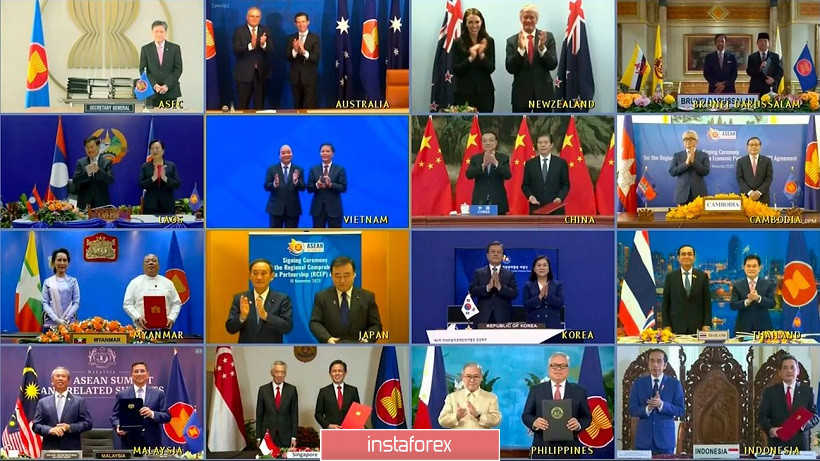The AUD/USD currency pair is moving to the limits of the 0.7300 again. The US dollar is showing weakness during the start of a new trading week, amid COVID-19 anti-records in the United States, which lowers anti-risk sentiment and slows down US inflation. In turn, the Australian dollar got a reason to strengthen over this weekend, and, oddly enough, China played an important role in this.

Trump finally lost hope of being re-elected last weekend, despite denying the obvious. On Saturday, it became known that Joe Biden took Georgia for the first time in 28 years: this state has traditionally voted for the Republicans since 1992, but the Democratic leader was able to change things in his favor this time. His victory in this region led to the final total of electoral votes: 306 votes for Biden and 232 votes for Trump (remember that 270 votes are needed to win). The candidate will be officially declared the winner of the presidential race on December 14, when the Electoral College votes for him. Therefore, it is clear that the Republican will not be able to change the situation through the courts, especially since the majority of judges refuse Trump to consider his claims. The evidence of this fact is also confirmed by the fact that Mr. Biden has already been congratulated by the leaders of the world's leading countries: from Canada to China. And so yesterday, Mr. Trump actually admitted defeat: he tweeted that Joe Biden won, but due to electoral fraud. In other words, traders can now finally turn over this chapter: The US presidential election is over.
This fact weakened the US dollar, since traders used this currency as a kind of safety net. However, other fundamental factors have currently come to the fore, which turned out to be not in favor of the US dollar.
First of all, we are talking about COVID-19. In the second half of October and the first half of November, this factor supported the US dollar for the same reason – it was used as a protective tool. But recently, investors are worried about the current situation in the United States, where the incidence of COVID-19 breaks all records. As an example, the number of detected cases was 187 thousand people last Friday, which is an absolute anti-record when it comes to the daily incidence rate. For comparison, this figure was 70-80 thousand in the middle of summer (peak periods), when USD was also weakening amid growing cases of COVID-19 in the US. And if these were only local outbreaks during the summer months, then at the moment, almost the entire territory of the States has become filled with COVID-19 cases.
In this regard, doctors are making a warning, pointing out that hospitals no longer have enough beds and specialists, while infectious diseases experts warn that in winter, the daily cases can grow to two hundred thousand. Against the background of such trends, many States at the local level began to tighten quarantine restrictions. In particular, the Governor in New Mexico announced the temporary closure of all businesses that are not associated with the production or sale of essential goods. Similar measures have been taken by the authorities of the state of Oregon. Experts believe that most of the country's States will be forced to tighten quarantine sooner or later; otherwise, the medical system will simply not cope with the load. Such prospects put background pressure on the US dollar, especially amid slowing US inflation. It should be recalled that disappointing data on CPI growth in the US were published on Thursday.

On another note, the Australian dollar received an additional reason yesterday to grow. It became known that the countries of Asia and the Pacific region signed an agreement on the creation of the world's largest free trade zone. This complex negotiations lasted more than 10 years: the negotiation process was blocked by India for a long time, which subsequently refused to participate in the agreement at all. India has been replaced by Australia, which is now also a member of the Regional Comprehensive Economic Partnership Agreement (RCEP). This agreement was signed by representatives of 15 countries, including China, Japan, South Korea and New Zealand and 10 more ASEAN members, which include, in particular, Singapore, Vietnam and Thailand.
In the context of the AUD/USD pair, the RCEP agreement should be viewed through the prism of the complex political relations between Australia and China. After all, the deal implies the abolition of tariffs for at least 90% of goods in trade between the participating countries. The very fact of signing the agreement supported the Australian dollar, as it eased concerns about China's latest actions in relation to Canberra (the actual ban on coal imports, increased customs checks, increased tariffs on a number of goods, etc.).
Thus, the current fundamental background suggests that the AUD/USD pair will retest the main resistance level of 0.7350 in the mid-term (the upper line of the Bollinger Bands indicator on the daily chart). In view of this, long positions can be opened either from current positions or when breaking the level of 0.7300.
 English
English 
 Русский
Русский Bahasa Indonesia
Bahasa Indonesia Bahasa Malay
Bahasa Malay ไทย
ไทย Español
Español Deutsch
Deutsch Български
Български Français
Français Tiếng Việt
Tiếng Việt 中文
中文 বাংলা
বাংলা हिन्दी
हिन्दी Čeština
Čeština Українська
Українська Română
Română

